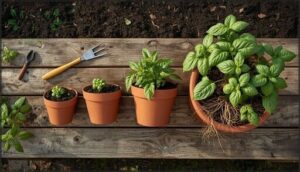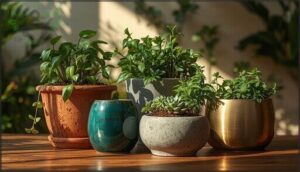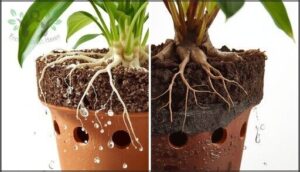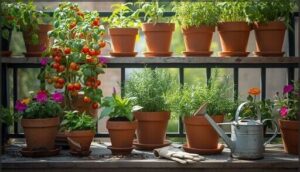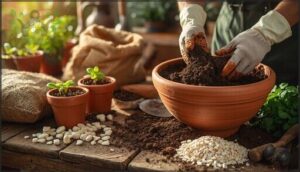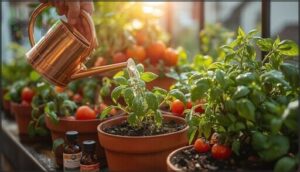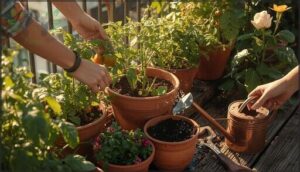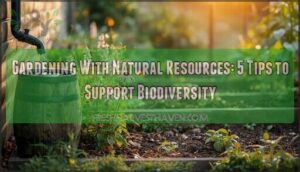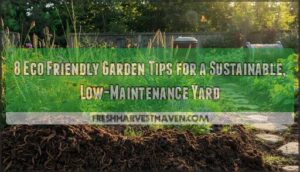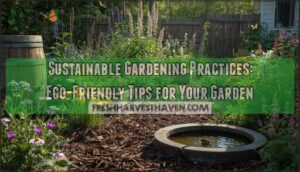This site is supported by our readers. We may earn a commission, at no cost to you, if you purchase through links.
You don’t need acres of land to grow your own food. A sunny balcony, patio, or doorstep can become a thriving garden with the right containers and know-how. Container gardening breaks the rules of traditional growing, giving you control over soil quality, drainage, and placement while working around poor ground conditions or limited space.
Whether you’re raising herbs on a windowsill or cultivating tomatoes on a deck, success comes down to matching the right plants with suitable pots and maintaining consistent care. The techniques are straightforward once you understand how container environments differ from in-ground beds and what your plants need to flourish in confined spaces.
Table Of Contents
- Key Takeaways
- Benefits of Container Gardening
- Choosing The Right Containers
- Selecting Plants for Containers
- Preparing Soil and Potting Mix
- Watering and Fertilizing Tips
- Maintaining Your Container Garden
- Frequently Asked Questions (FAQs)
- How often should I rotate my container plants?
- What plants grow best together in containers?
- Can I grow fruit trees in containers?
- How do I prevent pests in container gardens?
- When should I repot my container plants?
- How do I prevent pests in containers?
- When should I replace old potting soil?
- Can I grow vegetables indoors year-round?
- What fertilizer schedule works best for containers?
- How do I protect plants from wind?
- Conclusion
Key Takeaways
- Container gardening lets you grow food in small spaces by giving you complete control over soil quality, drainage, and light exposure—no yard required.
- Match your container size to your plant’s needs (tomatoes need 5 gallons, herbs need 2-3 gallons), use quality potting mix instead of garden soil, and make sure every pot has proper drainage holes.
- Water when the top two inches of soil feel dry, feed container plants every 1-3 weeks since nutrients wash out quickly, and add a 5 cm layer of mulch to cut watering frequency in half.
- Rotate pots weekly to prevent lopsided growth, group plants with similar water and light needs together, and choose compact or dwarf varieties that won’t outgrow their containers.
Benefits of Container Gardening
Container gardening opens up a world of possibilities, whether you’re working with a tiny balcony or just don’t want to deal with less-than-perfect yard soil. You can grow everything from fresh herbs to juicy tomatoes without the limitations of traditional in-ground planting.
Let’s look at the key advantages that make container gardening such a practical choice for gardeners at any level.
Flexibility and Space Efficiency
Container gardening transforms tight spaces into productive growing areas. You can stack containers vertically to support 40-50 plants in just four square feet, or turn your balcony into a garden that yields up to 10 times more per square foot than traditional methods.
Mobile containers let you follow the sun throughout the day, boosting your light exposure by 30%. Whether you’re working with a rooftop, patio, or windowsill, containers adapt to your space.
It’s especially useful in urban areas, making balcony container gardens a popular option.
Growing Plants With Poor Soil
When your yard has clay, sand, or rocky ground, you don’t need to fight it. Containers let you skip the soil testing and amendments altogether. You control everything from day one with quality potting mix.
Here’s what makes containers work:
- No soil-borne diseases carried over from previous seasons
- Custom drainage solutions for plants with specific needs
- Precise nutrient management without guessing about deficiencies
Your plants get exactly what they need. Because containers have limited soil, it’s important to focus on nutrient management strategies.
Easy Access and Maintenance
Beyond the soil benefits, you’ll appreciate how containers bring plants right to you. Raised planters at 24 to 36 inches high let you garden from a seated position, eliminating bending and kneeling.
That ergonomic height means wheelchair access becomes simple, and routine watering, fertilizing, and plant care turn into quick daily checks rather than back-breaking chores—container gardening tips that support real health benefits through simplified tasks.
Choosing The Right Containers
Picking the right container isn’t just about what looks nice on your patio. The size, material, and drainage features all play a role in whether your plants will thrive or struggle.
Let’s walk through what you need to think about when choosing containers for your garden.
Selecting Suitable Pot Sizes
Picking the right pot size directly affects your plants’ success. Volume requirements vary by crop—tomatoes thrive in 5-gallon containers, while herbs need just 2–3 gallons. Root depth matters, too: carrots require 10–12 inches, but shallow annuals manage with 6–8 inches.
Understanding pot conversions helps: a 12-inch diameter pot holds roughly 5 gallons. Proper container size recommendations help create healthy growth effects and better yields.
Understanding Container Materials
Your choice of pot material shapes watering frequency, temperature stability, and plant health. Each option brings trade-offs worth weighing:
- Plastic pots — Light, affordable, and durable, but they can trap heat in dark colors and offer minimal insulation.
- Terracotta porosity — Breathable walls cool roots by 2–4 °C yet dry out fast, demanding more frequent watering.
- Ceramic pots — Glazed finishes retain moisture well and provide weight for stability, though they’re heavy to move.
- Concrete pH — Thick walls buffer temperature swings, but unsealed surfaces may gradually raise substrate alkalinity.
- Metal insulation — Steel and aluminum planters last decades, yet dark finishes can push root zones above 38 °C on hot days.
Composite weight balances longevity with portability. Choosing container types and container materials that match your climate, plant selection, and lifting capacity sets you up for success.
Ensuring Proper Drainage
Without open drainage holes, waterlogged soil suffocates roots within hours. Colorado State University Extension confirms that pore spaces fill with water, starving roots of oxygen and triggering rapid plant failure. Drill multiple openings in the base of any sealed pot—metal, plastic, or glazed ceramic—before adding your potting mix choice.
Drainage Design Essentials
| Element | Correct Practice | Why It Matters |
|---|---|---|
| Drainage hole size | Multiple openings, at least 1 cm wide | Allows excess water to exit freely and air to reach roots |
| Drainage layer myth | Skip gravel at bottom; use uniform mix throughout | Gravel creates a perched water table, slowing drainage and increasing overwatering effects |
| Container material impact | Pair porous clay with well-draining media; seal metal/plastic with holes | Non-porous walls depend entirely on bottom drainage to prevent saturation |
| Potting mix choice | Soilless blend: peat, perlite, vermiculite | Ensures rapid soil drainage and aeration without compaction |
Washington State’s Garden Professors warn that coarse layers concentrate moisture above the root zone rather than speeding its exit. Proper soil and drainage start with a uniform, aerated medium extending from surface to base—no rocks required.
Container garden drainage hinges on these fundamentals, protecting your plants from root rot and maximizing their vigor.
Selecting Plants for Containers
Not every plant will thrive in a pot, so choosing the right ones makes all the difference. You’ll want to focus on varieties that stay manageable in size and share similar care needs.
Let’s look at which vegetables, herbs, and flowers work best for container growing.
Best Vegetables, Herbs, and Flowers
You can grow plenty of herbs, vegetables, and annual flowers in containers with great success. Basil, thyme, rosemary, and parsley are reliable herb container selections that thrive in pots.
High-yield vegetables like cherry tomatoes can produce 4–8 kg per plant, while bush beans and lettuce offer quick harvests.
For ornamental container plants, petunias and shade-loving flowers like impatiens provide continuous color throughout the season.
Compact and Dwarf Varieties
Compact and dwarf pot plant varieties make container gardening possible even when you’re working with limited resources and tight spaces. These patio varieties deliver impressive early yields while maximizing space optimization.
Consider these proven performers:
- Dwarf tomatoes like ‘Red Robin’ reach harvest in just 55–68 days and thrive in 19-liter containers
- Bush cucumbers such as ‘Spacemaster’ grow on 60 cm vines yet produce full-sized fruit
- Dwarf fruit trees on compact rootstock influence final height to just 1.2–1.8 meters
These plant selection choices fit balconies perfectly while maintaining full productivity.
Grouping Plants With Similar Needs
Think of your container like a studio apartment—everyone sharing the space needs to get along. When choosing plant combinations, match light requirements first: sun lovers like peppers and marigolds thrive together, while shade-preferring ferns need their own spot.
Group by moisture needs and nutrient alignment too. This plant selection strategy simplifies watering schedules and prevents some plants from struggling while others flourish. Temperature tolerance and form integration complete successful pairings.
Preparing Soil and Potting Mix
The right soil mix can make or break your container garden. You can’t just scoop dirt from your yard and call it a day—containers need something lighter and more specialized.
Let’s look at what goes into creating the perfect growing environment for your potted plants.
Choosing Quality Potting Mix
Picking the right potting mix is like choosing a good foundation—it makes everything else easier. Skip garden soil; you need container soil management that provides proper media porosity and moisture retention for healthy roots.
- Look for sustainable mixes listing peat, coir, bark, or perlite as primary components, with component proportions around 60-80% organic matter
- Check that the potting soil includes starter fertilizer for nutrient content
- Verify soil quality by choosing products specifically labeled for containers
Improving Drainage and Aeration
Once your potting mix is chosen, you can boost drainage and aeration with coarse amendments like perlite or bark—adding 20-30% improves air pockets and prevents waterlogged roots.
Make sure drainage holes cover at least 20% of the container base, or consider fabric bags that let excess water escape through the sides and promote oxygen-rich root zones through continuous air exchange.
Adding Fertilizer and Amendments
With drainage optimized, you’ll want to layer in nutrients. Many commercial potting mixes include starter fertilizer, but plants quickly deplete container soil. Organic amendments—compost blended at moderate rates—build long-term reserves, while slow-release granules (about 18 g per gallon pot) deliver steady nutrition. Liquid feeding every few weeks supplements growth, and testing soil pH ensures your plants absorb nutrients efficiently.
- Mix controlled-release fertilizer into fresh media before planting
- Top-dress established containers with organic compost mid-season
- Apply liquid feed at 1 teaspoon per gallon water weekly
- Incorporate biochar at 5–10% by volume for nutrient retention
- Monitor soil pH to keep nutrients available to roots
Watering and Fertilizing Tips
Once your containers are set up with the right soil, keeping your plants healthy comes down to two main tasks: watering and feeding. Get these basics right, and your plants will reward you with strong growth and abundant harvests.
Here’s what you need to know to keep your container garden thriving.
How and When to Water Containers
During warm seasons, you’ll want to water container gardening setups when the top two inches of soil feel dry. Check soil moisture each morning—that’s when watering timing works best, helping foliage dry quickly and reducing disease risk. Water until about 5–10% drains from the holes, ensuring thorough coverage.
Drip systems and self-watering containers offer efficient watering techniques for containers while preventing over/under watering problems.
Using Mulch to Retain Moisture
Once you’re keeping your containers hydrated, mulch helps you water less often. A 5 cm layer of organic mulch—pine bark, grass clippings, or straw—cuts soil evaporation by about 60% during hot days. That means irrigation frequency drops from twice daily to every 2–3 days in summer heat.
Mulch thickness matters: 10 cm retains roughly 10% more moisture than 5 cm, creating microclimate effects that shield soil from sun and wind while improving water retention in container gardening setups.
- Apply at least 5 cm of mulch to reduce surface evaporation considerably
- Choose fine-textured mulch types like grass clippings or hemp bedding for best moisture retention
- Water deeply before mulching to heighten the moisture-conserving benefits
- Keep mulch away from plant stems to prevent rot and pest issues
- Refresh mulch mid-season as organic materials decompose and thin out
Fertilizing for Healthy Growth
Nutrient deficiencies show up fast in containers—nitrogen runs out in 6–8 weeks without feeding. Use water-soluble fertilizer like 10-10-10 every 1–3 weeks, or mix slow-release granules at planting for 8–12 weeks of feeding. Fish emulsion and worm castings work as organic options.
High-strength formulas need careful dilution to prevent salt burn, and frequent watering leaches nutrients, so consistent fertilizing keeps container plants thriving.
Maintaining Your Container Garden
Getting your containers planted is just the beginning—keeping them healthy takes a bit of ongoing care.
A few simple maintenance habits will help your plants stay strong and productive all season long.
Here’s what you need to focus on to keep your container garden thriving.
Providing Support for Tall Plants
Tomatoes, cucumbers, and other tall crops will topple without proper support. Staking materials like bamboo or coated steel help maintain structural stability while improving plant health—trials show staked tomatoes yield up to 97 tons per hectare more than unsupported plants.
Your container gardening tips should include:
- Choose lightweight trellises that won’t overload balconies
- Use sturdy stakes to boost labor efficiency during harvest
- Select reusable materials like treated bamboo
- Install support early for best plant growth
Managing Pests and Diseases
Check your plants weekly for pest identification—look for holes, distorted leaves, or powdery coatings that signal pests and diseases.
IPM strategies combine monitoring practices with organic solutions: hand-pick insects, improve air circulation for disease prevention, and use insecticidal sprays only when needed.
Early detection protects plant health while reducing chemical use in your pest control routine.
Overwintering Perennials in Containers
Overwintering perennials in containers takes extra planning because root hardiness drops 10 to 20 degrees compared to in-ground plants. Choose perennials two zones hardier than your area, then use insulation methods like grouping potted plants and surrounding them with mulch or straw. Protected structures—unheated garages or sheds—work well.
Container perennials need two-zone hardier varieties and winter insulation since their roots are far less cold-tolerant than in-ground plantings
Moisture management matters: water during thaws above 40°F to prevent desiccation while avoiding soggy soil.
Relocating Containers for Sunlight and Temperature
Moving your containers isn’t just about aesthetics—it’s a practical tool for managing sunlight exposure and temperature extremes. Vegetable and flowering plants need 6 to 8 hours of direct sun, but root zones can hit 104°F in full sun, stressing growth.
Relocate pots seasonally to:
- Exploit microclimates near walls or under eaves
- Reduce heat stress on reflective surfaces
- Balance changing sun angles through summer
Adjust watering as location shifts.
Frequently Asked Questions (FAQs)
How often should I rotate my container plants?
Give your container plants a quarter turn each time you water—usually weekly—to prevent lopsided growth.
Adjust rotation based on light exposure, growth habit, and whether stems lean toward sunlight.
What plants grow best together in containers?
Group plants with matching needs: pair rosemary, thyme, and sage in dry containers, or combine basil with parsley for moisture-lovers.
Mix tall vegetables with trailing annuals, or layer perennials with seasonal flowers for visual interest.
Can I grow fruit trees in containers?
You can definitely grow fruit trees in containers—dwarf varieties on size-controlling rootstocks thrive in 20–30 gallon pots.
Proper container size, regular watering, nutrients, and sun guarantee good yield potential, though overwintering requires protection in cold climates.
How do I prevent pests in container gardens?
You can prevent pests and plant diseases through IPM strategies: inspect plants weekly for pest monitoring, use sanitation practices to remove debris, maintain soil health with proper watering and nutrients, and apply biological controls when needed.
When should I repot my container plants?
When roots start playing musical chairs through drainage holes, it’s time to act. Repot container plants every 2-3 years, watching for root-bound signs, growth stagnation, faster watering frequency, and compacted soil condition—ideally during spring’s active growing season.
How do I prevent pests in containers?
Keep containers clean by removing dead leaves and debris regularly.
Use fine mesh netting as physical barriers, apply insecticidal soap for soft-bodied pests, and add companion plants like basil to naturally deter insects while supporting plant health.
When should I replace old potting soil?
You should replace potting soil when it shows physical degradation like compaction, poor water retention, or nutrient depletion.
Replace annually for heavy feeders, every 12–18 months for houseplants, or when disease risk and salt buildup appear.
Can I grow vegetables indoors year-round?
Yes, you can grow vegetables indoors year-round with proper indoor lighting, temperature control, and space requirements.
Warm-season crops like tomatoes need 14–20 hours of light daily, though energy costs and pest management require attention.
What fertilizer schedule works best for containers?
You’ll want to feed container plants every two to three weeks with diluted liquid fertilizer during active growth. Fruiting crops like tomatoes need weekly feeding, while monitoring EC targets prevents salt buildup and overfertilization.
How do I protect plants from wind?
An ounce of prevention is worth a pound of cure”—protect container plants from wind by using windbreak materials, securing containers with weight or straps, and selecting wind-tolerant species.
Position pots in sheltered microclimates and add support through trellises or stakes.
Conclusion
Think of your containers as portable gardens that go wherever opportunity calls. With these gardening tips for container gardening, you’ve gained the tools to transform any sunny spot into productive growing space.
You control the soil, manage the water, and relocate plants as seasons shift. Start small, learn what your plants tell you, and watch your confidence grow alongside your harvest. The only limit is the space you’re willing to claim.
- https://harvesttotable.com/pot-and-container-sizes-for-growing-vegetable-crops/
- https://kansashealthyyards.org/all-videos/video/growing-veggies-in-pots-select-the-right-size
- https://blogs.oregonstate.edu/gardenecologylab/2021/08/27/tylers-research-on-containerized-vegetable-gardens/
- https://www.datainsightsmarket.com/reports/gardening-container-354077
- https://earthbox.com/blog/what-is-the-best-soil-for-container-gardening


